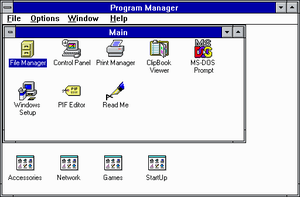Program Manager
| A component of Microsoft Windows | |
|---|---|
|
Program Manager in Windows for Workgroups 3.11 | |
| Details | |
| Type | Shell |
| Included with | Windows 3.0 to Windows XP Service Pack 1 |
| Replaces | MS-DOS Executive |
| Replaced by | Windows Explorer |
| Related components | |
| File Manager (Windows) | |
Program Manager is the shell of Windows 3.x and Windows NT 3.x operating systems. This shell exposed a task-oriented graphical user interface (GUI), consisting of icons (shortcuts for programs) arranged into program groups. It replaced MS-DOS Executive, a file manager, as the default Windows shell.
Program Manager descends from PMShell, the shell for OS/2 1.2, and shares the same icons. Unlike PMShell, which presented its program groups in a simple list, Program Manager opens program groups in child windows using the new multiple document interface in Windows 3. It is possible to run PMShell in Windows by using Presentation Manager for Windows; in that case, PMShell will read the Program Manager groups via DDE.
When executables were dropped into Program Manager from File Manager, Program Manager automatically used the executable's default icon embedded as data inside the .EXE file. Additionally, the Windows Setup program, which populated Program Manager with the standard icons of a fresh install, could also be used to add new icons in bulk after installation. Using SETUP /P from the command line, a standard layout could be installed on many machines in an enterprise using a single SETUP.INF configuration file.[1]
Beginning with Windows 3.1, Program Manager contained a StartUp group. Programs and files placed into that group would be loaded when Windows starts.
Holding down the shift key while mousing FILE then EXIT WINDOWS will save the current configuration of Program Manager to PROGMAN.INI, including the position of all program group icons, assuming that auto-arrange has been disabled. This allowed Microsoft testers to try many different configurations, but the feature remained in the shipped version.[2]
In later versions of Microsoft Windows, starting with Windows 95 and Windows NT 4.0, Program Manager was replaced by Windows Explorer as the default shell. Specifically, the Start Menu took over program organization and launching duties. However, Windows 95 still gave the user the option to start Program Manager at boot.
For backward compatibility with old applications, Program Manager was still included in later versions of Windows, and could be accessed by executing PROGMAN.EXE from the command line or Run dialog. If the user wished, it could be used as the default shell by specifying the Shell value in the registry at either HKLM\SOFTWARE\Microsoft\Windows NT\CurrentVersion\Winlogon (per machine) or HKCU\SOFTWARE\Microsoft\Windows NT\CurrentVersion\Winlogon (per user).
Today, Program Manager has little practical use beyond compatibility with pre-Windows 95 programs. Microsoft removed Program Manager from Windows XP Service Pack 2, and the executable only serves to convert Program Manager shortcuts to Windows Explorer shortcuts. In Windows Vista, PROGMAN.EXE has been removed entirely.

.svg.png)